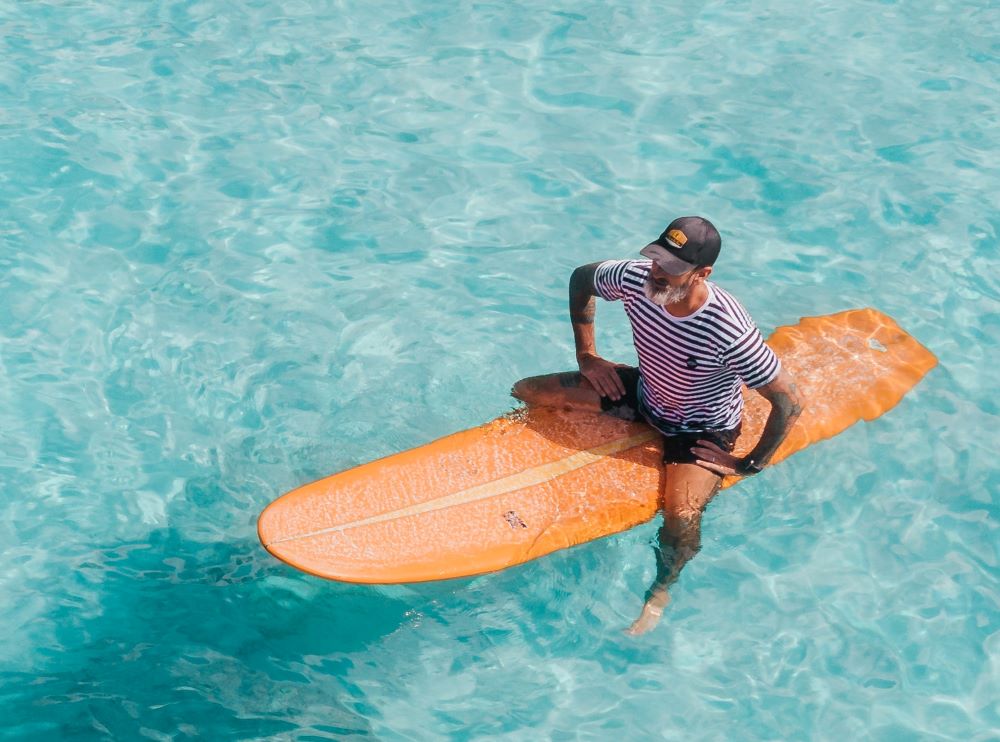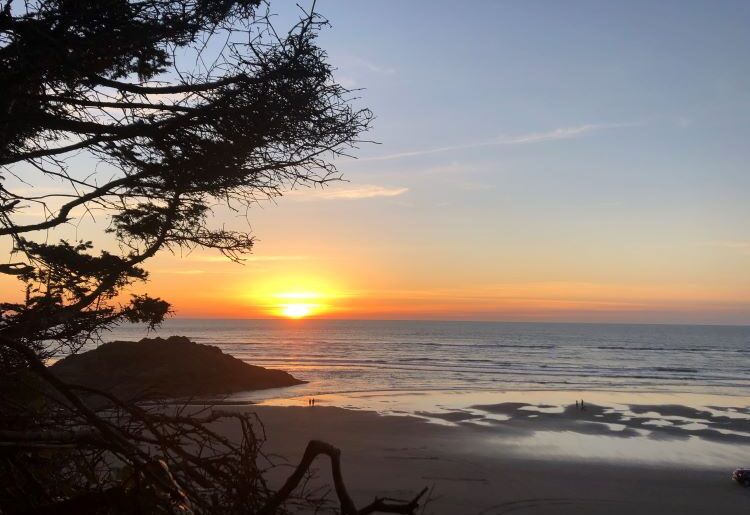It’s important to protect your eyes while surfing. Out on the water, your eyes are exposed to harmful UV rays, wind, sand, and salt. The sun is the biggest danger.
Surfers often spend hours on the water in a single session and many people surf multiple days per week. Prolonged exposure to the sun can cause cancer, growths, and vision loss. Therefore, it’s important to be aware of these risks and protect your eyes before it is too late.
Fortunately, there are several effective methods to protect your eyes while surfing.
| Methods: | Surf at certain times of the day | Surf hats | Surf sunglasses | UV blocking contact lenses |
| Level of eye protection | Medium – High | Low – Medium | High | Low – Medium |
| Level of skin protection | None | Low – High | None | None |
| Profile | None | Low – High | Low | None |
| Pros | – No extra gear | – Affordable – Eye and skin protection – Styles for different conditions | – Best eye protection – Low profile – Prescription available – Easier to wear with a hood | – No extra gear |
| Cons | – Time restriction | – Catches water – Can drip water – Hard to wear with hood – No protection from glare | – Fogging – Water drops on lenses – Can be expensive | – Low protection – Eye irritation – Hassle to manage |
| Cost | None | $20 – $70 | $50 – $250+ | Variable |
Option 1: Surf at certain times of the day
The easiest way to keep the sun out of your eyes while surfing is to surf only at certain times of the day when the sun is at your back or above you.
I live on the west coast of Oregon in the United States. The sun sets in the west and is therefore in my eyes in the late afternoon and evening if I am surfing. As a result, I try to surf mostly in the morning and midday, when the sun is at my back.
That said, sometimes you are inclined to surf at a time when the sun is in your eyes. Maybe the waves are great and you just have to be out there! I understand. In these cases, you do have some other options.
Option 2: Wear a surf hat
Another option to protect your eyes while surfing is to wear a surf hat. Surf hats protect both your eyes and your skin from the sun. Depending on the style, surf hats offer different levels of protection and have a different profile.

On small days, you can probably wear any old hat you like. If it falls off you can just pick it up again. However, if you’re duck diving or wiping out often you probably want a hat that is secured to your head via a chin strap, a short leash, or both.
I personally don’t usually wear a hat while surfing. However, if the sun is in my eyes and the waves are small I will wear a hat. I have a bucket hat that has a tie that keeps it on my head. It does fall off occasionally, but not too frequently.
Types of surf hats
If you fancy buying a hat specially made for surfing, you have some options. Again, the main styles are bucket hats, ball cap/trucker hats, and surf caps. Different styles have different levels of sun protection and different profiles. For an in depth look at surf hats, check out my ultimate guide to surf hats.
Bucket hat style: Kaiola – Surf Bucket Hat
A bucket style surf hat has a medium to large brim that encircles your whole head. This style of surf hat offers the most sun protection, but also has the largest profile, which means it will grab more water when duck diving or during wipeouts.
Ball cap/trucker hat style: Kaiola – Surf Hat
The ball cap/trucker hat style offers sun protection from only the front and usually has a medium to large brim. This style of hat has a lower profile than the bucket hat style, which is typically better for larger surf, where duck dives and wipeouts are more intense.
Surf cap style: Dakine – Surf Cap
A surf cap is a hat with a short brim. It offers less sun protection than a bucket hat and ball cap/trucker hat, but in exchange has a lower profile. This means it will be more secure and can handle larger surf. The surf cap is the most minimal option while still offering some sun protection.
Downsides of surf hats
Surfing hats are a great option for protecting both your eyes and your skin. However, surf hats do have their downsides.
First and foremost, surf hats do not block the glare of the sun that reflects on the water. This isn’t so much of an issue mid-day. However, when the sun is low in the morning or the evening, there can be a lot of glare.
Secondly, surf hats get in the way during wipeouts and duck dives. Even if they are secured to your head, they will be pulled by the turbulence of the water and affect how you move underwater. This can create extra drag during duck dives and turtle rolls.
Thirdly, surf hats can shift and even fall off your head if they are not secured properly. If the chin strap is not tight enough, the surf hat will fall off. In contrast, if the chin strap is too tight or made of certain materials, it will be uncomfortable.
Furthermore, surf hats may hold onto water and drip it in your eyes.This is one reason why the material of the surf hat is important.
Finally, surf hats can be difficult to wear with wetsuit hoods. They won’t fit the same with and without a wetsuit hood. Many hoods also have a small brim to keep water out of your eyes. This may cause additional issues with fitting.
DIY surfing hat
Don’t feel like spending money on a surf hat? No problem. Just DIY. To make a DIY surf hat, just use any hat you prefer and secure it to your head or wetsuit using a chin strap or a leash.
You might have to get creative with the chin strap. Alternatively, you can skip the chin strap and just use a hat leash. I talk more about DIY surf hats in my ultimate guide to surf hats.
Option 3: Wear surf sunglasses
Surf sunglasses offer excellent protection for your eyes out on the water. Many people use sunglasses in their everyday lives. Why not use them surfing?.
Unlike a surf hat, surf sunglasses block the glare on the surface of the water in addition to the direct sunlight. In this way, surf sunglasses do protect your eyes better than a surf hat.
However, surf sunglasses don’t protect your skin. So make sure you wear sunscreen. On the plus side, surf sunglasses have a low profile, and won’t catch as much water during duck dives or wipeouts as hats.
Surf sunglasses are also easier to wear with hoods. Many surf sunglasses have a head strap that can go inside or outside of a hood. Curious to learn more? Check out my ultimate guide to surf sunglasses.
Best surf sunglasses
These are some of the most popular surf glasses.
LiP – Typhoon
One of the more high end options, the LiP Typhoon has all the best bells and whistles you might want in a pair of surf sunglasses. They have high quality lenses and materials, as well as a solid strap system and even a leash system with a necklace.
Sea Spec – Classic
The Sea Spec Classic has just the essentials and is one of the most affordable sunglasses in this list. According to the website, Sea Spec’s mission is to make affordable water sports sunglasses. They have normal and prescription models.
Rec Specs – Maxx Air
Recs Specs is a recreation sports glasses company that has a ton of different models for different sports. The Maxx Air model has a serious ventilation system made to prevent fogging. These are a bit on the pricey side but you get a quality product from a reputable company.
Downsides of surf sunglasses
Surf sunglasses do have their cons. One common issue, especially in colder water, is the lenses fogging up. Another problem is water droplets on the lenses that restrict vision. Some sunglasses have special venting slots and lens coatings to prevent these issues.
Surf sunglasses must have lots of padding and fit well to your face. WIthout a good fit and proper padding, they might be uncomfortable. Comfort is especially important because most models are secured tightly to your face with a head strap.
Another downside is the cost. Surf sunglasses need to be built to withstand the impact of the waves and must have a secure strap system. All this engineering means a higher price. The cheapest surf sunglasses are around $50 and can go for more than $250. You can get a solid surfing hat for $40 – $60 or less.
DIY surf sunglasses
Just like with surf hats, the innovators may take a stab at creating their own surf sunglasses. You can use normal sunglasses (just make sure they have impact resistant and UV blocking lenses) and develop a strap system of your own.
You can even skip the strap system and just leash them to your wetsuit. This way, you don’t need them to be secured to your head and have the padding needed for comfort. You can just put them on once you paddle back out to the break.
Option 4: UV Blocking Contact Lenses
Perhaps one less conventional option is UV blocking contact lenses. Many brands offer UV blocking contact lenses and at first thought, it seems like a great solution. However, they are not 100% UV blocking like many sunglasses.
Furthermore, they don’t protect your whole eye like sunglasses do. The American Academy of Ophthalmology actually says that UV blocking contact lenses won’t protect your eyes from the sun.
That said, they are probably better than nothing. Although contacts will cause irritation for many people after a few hours in the water, they are tolerable for many people. Many people rely on contacts. If you use contacts anyways, you might as well get UV blocking ones for surfing.
Final Thoughts
In reality, few of us are as kind to our eyes (our future selves) as we should be. The turbulence of the water makes eye protection while surfing a challenge. It is not always a first priority to protect your eyes while surfing, but it really is important.
I recommend all surfers at least give these methods a shot to protect your eyes while surfing. Try different options and find what works best for you and what you will actually use. Don’t buy a fancy pair of surf sunglasses if you won’t wear them.
For the most protection, combine one or more methods together. For example, maybe pair surf sunglasses with a surf hat. This might help hold both more securely in place and give you more protection from the sun.
If you surf frequently, do your future self a favor and try to protect your eyes while surfing. They are the only ones you will ever get!
Heads up! Surfing is awesome but it can be dangerous! Learn more about how to stay safe and avoid dangers while surfing. If you are a beginner surfer, check out my other articles about surfing and my ultimate guide to learning how to surf.




![Best longboard surfboards [2023] – all skill levels surfer with surf hat](https://mindfulladventure.com/wp-content/uploads/2022/10/surf-hat-crop-1000-270x180.jpeg)




